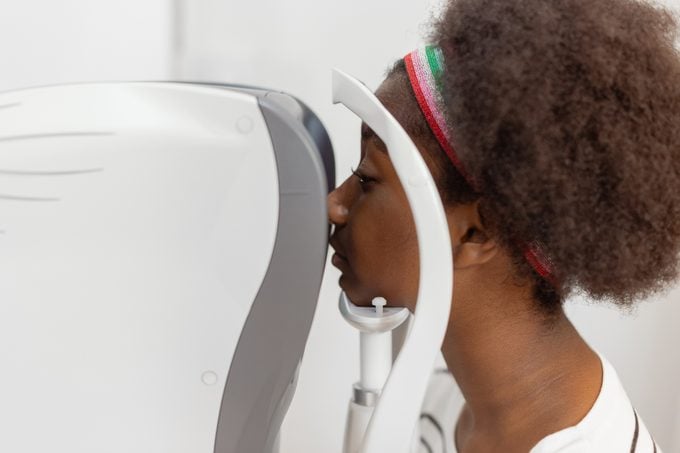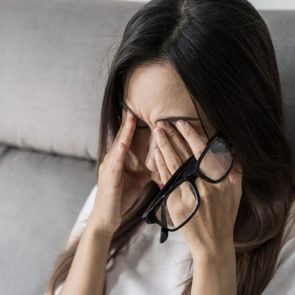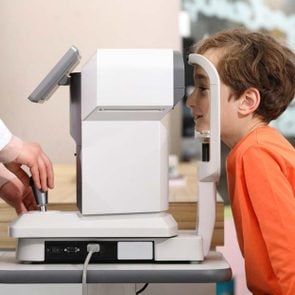What Does It Mean to Be Nearsighted? 4 Myopia Symptoms to Know
Updated: Oct. 07, 2021
Have you noticed you can't read street signs as clearly, or that it's getting hard to see the football from your stadium seat? You might have developed nearsightedness.
What is myopia?
Myopia is a common eye-focusing disorder that affects distance vision. With myopia (also called nearsightedness), you can see objects that are near, but your vision is blurry when you focus on things farther away.
So, for example, you can check Facebook on your phone or iPad with no problem, but you might have trouble reading roads signs clearly or the squirrel (or is a rabbit?) in your backyard.
Myopia affects about 41.6 percent of the population in the United States, according to the National Eye Institute. For this reason, there are a lot of people wearing glasses, contact lenses, or having surgery for better vision. Here’s what you need to know about this disorder.

What going on in the eye?
So why do some people’s eyes struggle to see things farther away? It’s due to a refractive error in the eye, meaning the eye does not refract (bend) light the way it should.
This occurs if the eyeball is too long from front to back, or the cornea is too curved. When light enters the eye, it doesn’t allow the retina to focus correctly.
With myopia, vision is clearer when objects are close and blurry when things are farther away. There is no cure nor procedure to reverse eyeball elongation, but wearing glasses, contacts, or surgery can correct nearsightedness.
Nearsighted vs. farsighted
Again, nearsightedness is the ability to see things close up clearly, but not far away.
Conversely, farsightedness is the ability to only clearly see objects that are far away.
Testing which objects in your view appear blurry may help you identify which visual issue is present. However, experts share more info below on surefire diagnostic tests.
Causes and risk factors of myopia
While the exact cause of myopia is unknown, scientists know genetics play a part. If both your parents are nearsighted, there’s a pretty good chance you’ll be wearing glasses or contacts, too.
In addition to genetics, how we use our eyes on a daily basis also may influence the possibility of developing myopia.
People, especially children, who spend a significant amount of time reading, working, or playing games on the computer, phone, iPad, or doing intense close visual work may be more likely to develop myopia, according to a 2020 study in Preventive Medicine.
However, some systemic reviews, like one in Ophthalmic and Physiological Optics, state the associations between screen time and myopia is inconsistent.
Still, a 2019 study published in Investigative Ophthalmology and Visual Science journal predicts 50 percent of the world’s population will develop some form of myopia by 2050.
Statistics aside, your eyes will thank you if you put the 20-20-20 rule into practice. (Every 20 minutes, take a 20-second break to look at something 20 feet away)
“It’s always a good rule of thumb to try and decrease the effects of stress and strain on the eyes,” recommends Richard Davidson, MD, an ophthalmologist at the UCHealth Sue Anschutz-Rodgers Eye Center in Aurora, Colorado.
“When we stare at a screen, we tend not to blink as often, and as a result, our eyes get dry and fatigued. Taking breaks like this is therefore very helpful.”
Symptoms of myopia
Common symptoms of myopia include:
- difficulty reading and seeing objects at a distance clearly
- squinting while trying to see properly
- eyestrain
- headaches
Night myopia
If your vision seems out of focus while driving at night, you might have night myopia. Your vision may be normal during the daytime, but become blurry in dimly lit situations.
“Because the pupil dilates in dim environments, more light enters the eye, and the light that enters in the periphery of the pupil results in more light being bent in the periphery of the lens compared to the center of the lens,” Dr. Davidson says. “Without going into too much detail, this essentially makes the person more nearsighted and blurs the vision at night.”
People with night myopia have difficulty driving at night, and might see halos around sources of light. Many also experience added eyestrain from trying to focus.
“In order to see better, giving a small glasses prescription for distance will compensate for these changes,” Dr. Davidson adds.
Diagnosing myopia

Myopia is most commonly diagnosed in childhood or before the age of 20. Diagnosing myopia is a painless and straightforward procedure that an optometrist or ophthalmologist conducts.
First is the classic vision test, where you’ll recite the letters you can read from a chart placed on the other end of the room to measure visual acuity (the clarity or sharpness of vision). If the tests point to myopia, a phoropter, which looks like an oversized pair of glasses with moveable lenses, is used to measure the amount of refractive error you have.
Your eye doctor flips through the lenses and asks which is best to see to help determine a specific prescription to correct your myopia. Another device, a retinoscope, shines light into your eye to observe the light reflection off the retina.
(Hey parents, besides pink eye, could you recognize these vision problems in your kids?)
At-home eye exams
If you’re thinking about skipping the eye doctor and doing a home test, you might want to reconsider.
For one thing, it is difficult to get accurate measurements, especially if you wear bifocal or progressive lenses. Plus, an eye doctor can spot other conditions during a routine eye exam that might otherwise go unnoticed.
“It’s still better to see an eye care provider who is going to examine the eyes and look for things like diabetes, high blood pressure, glaucoma, etc. Something that cannot be done via these websites,” Dr. Davidson says.
Treatment for myopia
Thankfully there are many options to treat myopia. The options vary depending on lifestyle and other vision concerns.
Eyeglasses
Depending on the degree of vision correction necessary, eyeglasses are a simple way to go. People with nearsightedness may only have to wear glasses when they need clear distant vision while driving, watching a game from the bleachers, or watching a movie.
Single vision glasses work great until around the age of 40, when most people develop presbyopia, a perfectly normal, age-related condition in which the ability to focus on nearby objects is nearly impossible without the help of reading glasses or a bifocal or progressive lens prescription. These lenses provide the ability to see up close and far away.
Contact lenses
Contact lenses sit directly on the eye and require a different exam to determine the precise corrective prescription. Many people experience sharper vision and a broader field of view, as contacts don’t interfere with peripheral vision as eyeglasses do.
Contact lenses are a viable option for people who do a lot of outdoor activities or play sports. And they don’t fog up like glasses when you’re wearing a face mask.
There are two basic types: soft contact lenses or rigid gas permeable lenses, and many variations within each type. Depending on your work, lifestyle, and vision needs, one type may be more suitable than the other to achieve optimal comfort and vision.
No matter which contact lenses you choose, don’t make these contact-wearing mistakes that could ruin your eyes.
Refractive surgery
If you’re tired of wearing glasses or contact lenses, refractive surgery might be an option. Commonly known as LASIK, Epi-LASIK, PRK, SMILE, and refractive lens exchange, these same day surgeries improve vision by reshaping the cornea.
Each surgery has its plus and minuses depending on recovery, vision goals, and lifestyle.
For example, LASIK surgery is a popular option because sharp and clear vision is typically restored within a few hours after the procedure, with little or no pain following the surgery. PRK, on the other hand, requires more healing time and precautions. It generally takes up to a month or more for vision to totally restore, but it is more suitable for people with a higher corrective prescription.
Lastly, refractive lens surgery is an option for myopia patients with high nearsightedness, or whose corneas are too thin for laser procedures. In a procedure similar to cataract surgery, a small, clear lens implant corrects myopia.
Complications
Myopia usually isn’t a major concern, but two myopia subgroups can have serious implications—high myopia and degenerative myopia.
High myopia
High myopia is a more severe level of nearsightedness that begins in early childhood and gets progressively worse into early adulthood.
It is described as nearsightedness of -5.00 or higher, producing uncorrected visual acuity of 6/120 or worse. That means a person with high myopia can read a letter at only 6 meters (roughly 19.5 feet) away.
Genes play a key role in developing high myopia, especially if both parents are notably nearsighted. High myopia isn’t generally associated with vision loss. However, people with the condition have a greater risk of developing several other vision-threatening conditions, including:
- Retinal detachment
- Glaucoma
- Cataracts
Degenerative myopia
Degenerative myopia is a rare and progressive form of myopia that can lead to blindness. Also called myopic degeneration or pathological myopia, it affects about 3 percent of the population, per the American Academy of Ophthalmology.
In this type of myopia, nearsightedness is particularly severe. Over time, the length of the eyeball stretches, resulting in the thinning of the sclera and retina, leading to quick and severe myopia and vision loss. People with a family history are most at risk for developing this condition.



